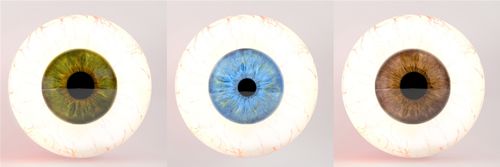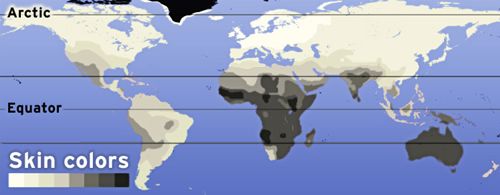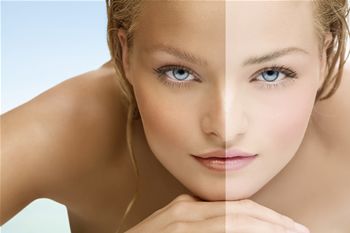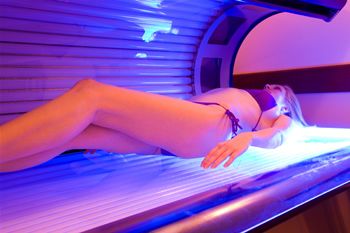A page from the "Causes of Color" exhibit...
Melanins, the pigments that color our eyes, hair and skin

Human beings come in a glorious spectrum of different colors: light, dark, plain or freckly skin; black, brunette, blond, auburn, and white hair; and eyes that are blue, hazel, green, amber and brown, to name just a few. It’s amazing to realize that most of this color is attributed to a single class of pigments: the melanins.
What are melanins?
Melanins compose a class of compounds that serve predominantly as a pigment. These pigments are derivatives of the amino acid tyrosine. There are at least three types of naturally occurring melanins: eumelanin, pheomelanin and neuromelanin. Both the chemical composition and the physical properties differ for the various types of melanin, suggesting that their chemical and biological responses may behave differently when exposed to light.
Although melanins are ubiquitous in humankind, our understanding of their chemistry is surprisingly limited. Melanin pigments have a complex natural structure that has defied detailed analysis. Once separated from living tissue, they form an amorphous mass and lose their inherent structure, making them very difficult to analyze.
What are the properties of melanins?
Melanins seem to be heterogeneous, with some small regions of order at the nanometer scale. The optical properties we can see depend on the ability of monomers and oligomers (made up of small numbers of monomers) that make up melanin to absorb light, and the ability of melanin particles to reflect and scatter incident light for different wavelengths. Melanins seem to have some semiconductor properties, and none of the proposed band models adequately account for this.

A comparison of the building blocks of eumelanins and pheomelanins
Eumelanin and pheomelanin play key roles in eye, hair, and skin color. Neuromelanin colors certain distinctive regions of the brain. This coloration is independent of skin and hair type. Abnormalities in neuromelanins correlate with various neurodegenerative diseases, such as Parkinson’s and Alzheimer’s.
Our eye color
Melanin is responsible for the color of our eyes. Variation in the color of our eyes from brown to green depends on the amount of melanin in the iris, which in turn is determined genetically. There are three genes that affect eye color, so it’s hard to pinpoint the exact color that a child’s eyes will be. Individuals with black or brown eyes have eyes with more melanin to block the sun’s rays. Those with blue, green, or hazel eyes have little protection from the sun and may experience discomfort, irritation, burning, and tissue damage if the eyes are not protected by sunglasses when exposed to bright light. Snow blindness is a well-known example of this kind of damage.
Hair color
Our hair color is also determined by varying amounts of melanin. The actual appearance of hair, and its overall reflective quality, is determined primarily by the pigment type, but also by the density and distribution of the pigment granules.
There are different types of melanin, and the ratio of these pigments produces different hair colors, again genetically determined. The mixture varies not only from one person to another, but also across one person’s head. Eumelanin is a dark pigment that predominates in black and brunette hair. There are two different types of eumelanin (brown eumelanin and black eumelanin). A small amount of brown eumelanin in the absence of other pigments apparently causes blond hair. Pheomelanin is a lighter pigment found in red hair, and is concentrated in the redder areas of the skin such as the lips. Because people with red hair are less able to make the dark eumelanin pigment, their skin is generally quite pale and burns easily with sun exposure.
Although people with dark hair may still produce the yellow-orange pheomelanin, it is largely masked by the dark eumelanin pigment and cannot easily be seen. However, the red-yellow pheomelanin is believed to cause the warm, golden, or auburn tones found in some types of brown hair. The range of colors produced by melanins is limited to shades of yellow, brown, red, and black. Grey hairs contain only a few melanin granules, spread out through the hair. White hairs contain no melanin at all: their whiteness is an optical effect, due to the way they reflect the light.
Often you find either eumelanin or pheomelanin in hair, but not both. Adjacent patches of hair follicles may show a very precise split between the two pigment types. This effect is most obvious in the patterns and markings of other mammals, such as leopards, tigers, and certain breeds of dog. Low levels of pheomelanin (in the absence of eulamelanin) are characteristic of cream-colored hair in many animals.
Pigments are discussed in more detail in the pages on blue eyes and green plants.
Skin color
Image showing the absorption spectra curve of melanin, and also the irradiance/insolation from the sun, and the absorption curve of DNA. (one graph).
Melanin reduces ultraviolet induced DNA damage by absorbing or scattering the ultraviolet radiation that otherwise would have been absorbed by the DNA. This prevents the development of melanoma, a potentially deadly form of skin cancer, as well as other health problems related to exposure to strong solar radiation. The amount of UV radiation that is absorbed or scattered is determined by a number of factors: the size, shape, and distribution of melanosomes, as well as the wavelength of the incident ray.
Skin color depends upon the size, number, shape, and distribution of melanosomes, as well as the chemical nature (level of activity) of their melanin content. There are 6 different skin types that are defined by dermatologists.
Table showing different skin colors
| Skin type | Description |
|---|---|
| Type 1 | Always burns, never tans. Very fair skin with red or blond hair and freckles. |
| Type 2 | Burns easily, tans minimally. Fair skin. |
| Type 3 | Sometimes burns, gradually tans. |
| Type 4 | Minimum burning, always tans. White, with medium pigmentation. |
| Type 5 | Seldom burns, always tans. Medium to heavy pigmentation. |
| Type 6 | Never burns, but tans very darkly. African Americans, Africans, or dark-skinned individuals with heavy pigmentation. |
Balancing the benefits and the dangers of ultraviolet radiation for differing climates
The darkest skin tones are found in tropical latitudes with open grassland, while areas further from the equator that are forested tend to favor lighter skin tones
There is a striking correlation between geographic conditions, particularly exposure to sunlight, and skin tone. These differences have evolved to find the balance between the benefits and the dangers of the ultraviolet (UV) radiation we absorb from the sun.
Early humankind living in the sun-soaked savannah plains of Africa developed a dark-toned skin, rich in the pigment melanin. Within the skin cells, melanin concentrates above the nucleus, shielding the vital DNA from radiation damage. In an environment where there is little to break the path of sunlight onto the skin, this barrier is a great advantage.
There are other benefits to having a high concentration of melanin in the skin and other parts of the body. Melanin boosts the immune system, and darker-skinned groups have been shown to have a lower incidence of a number of serious diseases, including Parkinson’s, multiple sclerosis, and spina bifida. Darker-skinned individuals also age better, as their skin is better protected from sun damage.
Vitamin D and skin color: finding a balance
It is the UV component of sunlight that helps the body utilize vitamin D. This vitamin helps promote bone growth, maintaining the right balance between calcium and phosphorus in the body. A deficiency of vitamin D leads to rickets and similar diseases.
It seems that, as early peoples migrated away from the equator into areas less exposed to the sun, there was not enough UV radiation to produce sufficient vitamin D to prevent diseases such as rickets. Their bodies compensated by producing less melanin, so that more sunlight would be allowed through. They could then produce sufficient vitamin D with less exposure to sunlight.
Light-skinned people visiting sunny locations may not have enough melanin to block the sun sufficiently, and may burn their skin without the protection of sunblock. Dark-skinned people visiting areas where there is less exposure to the sun may apparently not produce enough vitamin D, but can get it from supplements or food sources. Many foods such as milk and bread are now vitamin D fortified.
As the distribution map of skin color shows, skin color variation is not deter mined purely by distance from the equator. For example, people in snow-covered areas often have a dark skin tone. This may be because they are exposed to high levels of reflected UV radiation from the snow, or because their diet with its high proportion of fish is rich in vitamin D.
|
Grains in breads and cereals are often fortified with vitamin D. |
Fish is a natural source of vitamin D. |
Tanning: darkening light skin
The popularity of tanning seems cyclical, alternately being perceived as a healthy vibrant look and as a worrying reminder of the dangers of sunburn and carcinogenic melanomas.
Light skin becomes darker upon exposure to ultraviolet radiation. Sunshine is the primary source of UV radiation, but artificial sources such as tanning beds produce similar effects.
Skin is alive, so when melanin is destroyed by UV ra diation, the skin responds to this damage. Skin cells will produce more melanin, replacing what has been lost and increasing the percentage of melanin in the skin. This melanin has two effects, acting as a barrier to protect the skin from further damage, and darkening the natural color of the skin. Ultraviolet light produced in a tanning bed causes the same effect.
Melanogenesis is the name of the process where melanins are produced by specialized pigment cells called melanocytes, in response to UV radiation. Melanin in our skin protects our DNA from damage by UV radiation. This creates a long-lasting tan. A tan effect is also created when existing melanin is oxidized, but this doesn’t last as long.
Regular tanning beds use several fluorescent lamps (see light bulbs and lamps) that have phosphor blends designed to emit UV in a spectrum that is somewhat similar to the sun. The radiation produced is primarily UVA, with some UVB always being emitted, but the combinations of UVA and UVB can vary. Tanning bulbs are long fluorescent tubes, and fall into two main categories: low pressure lamps and high-pressure bulbs. Each bulb typically has a power between 100W and 200W. Alternative designs use high-powered parabolic lamps. The number of bulbs used by tanning beds vary: those designed for the home use 20 to 30 bulbs, commercial beds use 30 to 40 bulbs, and specialist stand-up booths use as many as 60 bulbs.
Tanning bed
A tanning bed or sun bed (whether at home or in a salon) is a device emitting ultraviolet radiation used to produce a cosmetic tan.
The World Health Organization (WHO) does not recommend the use of UV tanning devices for cosmetic reasons. Overexposure to UV radiation from the sun and artificial sources is of considerable concern for its adverse effects on health. UV radiation plays an important role in the development of skin cancer, cataracts, (see colorblindness), and other eye conditions. It also suppresses the immune system. Cumulative UV radiation ages the skin prematurely.
Tanning lotions
An alternative method of darkening the skin is the use of tanning lotions. These lotions use a wide range of active ingredients. One of the original sunless tanning lotions caused streaking and an orange skin tone, which gave the fake tan a bad reputation.
Lotions that contain dihydroxyacetone (DHA) as the active ingredient are used in many sunless tanning products. DHA, which is derived from plant sources like sugar beets and sugar cane, is a colorless sugar that interacts with the dead cells located in the stratum corneum of the epidermis. As the sugar interacts with the dead skin cells, a color change occurs. This change usually lasts about five to seven days from the initial application.
Another sunless tanning product is a tanning pill that contains canthaxanthin, most commonly used as a color additive in certain foods (see plants and other organic molecules). While the FDA has approved the use of canthaxanthin in food, it does not approve its use as a tanning agent. When used as a color additive, only very small amounts of canthaxanthin are necessary. As a tanning agent, however, much larger quantities are involved. Upon taking the tanning pill, canthaxanthin is deposited all over your body, including in your skin, which turns an orange-brown color. Various side effects, including canthaxanthin retinopathy, a condition in which yellow deposits form in the retina of the eye, have been identified.
Most tanning accelerators are lotions or pills that contain the amino acid tyrosine. The producers claim that the tyrosine stimulates and increases melanin formation, thereby accelerating the natural tanning process. However, more scientific data is needed to determine the validity of these claims and to assess the safety of using large amounts of tyrosine.
Another popular form of sunless tanning is the bronzer. These powders and moisturizers, once applied, create a tan that can easily be removed with soap and water. More like make-up, these products tint or stain your skin only until they are washed off.
Lightening dark skin
While some light skinned people tan or use cosmetic means to darken their skin, dark-skinned people may use cosmetic means to lighten their skin. This is an even more controversial process than tanning, as the desire for whiter skin is intertwined with issues of health, self-image, racial inequalities and colonial attitudes.
The term skin whitening covers a variety of cosmetic methods used to lighten the skin’s color. Most skin-lightening treatments are aimed at inhibiting tyrosinase, to reduce or halt the production of melanin. Exfoliants such as topical cosmetics or chemical peels may be used, or the skin may be treated with lasers, depending on the response of the individual’s skin to treatment. As with some tanning products, there is some evidence suggesting that there are harmful side effects to skin-lightening products.











